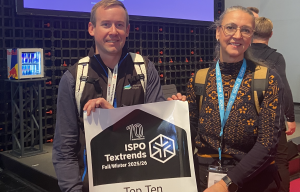
Dimension-Polyant gets ISPO Textrends Award
New for this season is a lighter quality of denim, a result of innovative spinning techniques, organisers of ISPO Textrends report.

22nd September 2014
Innovation in Textiles
|
Munich
The return to the traditional roots of denim will provide a plethora of deep indigo colours for Autumn/Winter 15-16 at ISPO Textrends Forum that will be presented right in the centre of the textile and fibre industry as part of ISPO Beijing 2015 and ISPO Munich 2015.
The original look will receive new life with the help of modern and sustainable dye methods, ozone and laser finishes, organisers report. In addition to this are worn, washed and used looks combined with classic twill structures, or new knit-style replicas and true knit, imitating traditional denim structures.
New for this season is a lighter quality of denim, a result of innovative spinning techniques. Stretch denim continues to be in high demand. Special treatments, antibacterial denim and combinations of denim and FIR nylon fibres promise function and performance.
Emana, the FIR yarn known from the active wear and undergarment segment, is said to provide denim with softer haptic and increased wear comfort. With its Denim Therapy brand, Tavex is one of the first denim manufacturers commercially producing FIR denim.
The activewear market has an impact on denim development. Improved knit denim qualities that imitate the woven styles, are in evidence. In addition, the market presents woven qualities reminiscent of classic interlock knit, with a softer haptic and improved fit. These fabrics mostly target the menswear segment.
Sustainability continues to be a primary topic within the denim industry. After years of excessive water consumption and uncontrolled application of chemicals, today the industry attempts to make good on the environmental sins of the past.
The stylish finishes are a result of ozone washes and laser finishes. Recycled synthetic materials are combined with denim. They are said to reduce material weight without changing the durability of the fabric, but most of all, minimise the number of washes needed for certain looks. Tencel is increasingly added to cotton to create a softer haptic.
Water and chemicals are not only used in the processing of denim, they are also a part of the cotton harvest. Even though conventional cotton continues to represent a major portion of source material, many manufacturers and brands have joined the Better Cotton Initiative (BCI).
This not-for-profit organisation dedicates itself to better cotton production. BCI works directly with cotton famers and educates them on the latest sustainable technologies, making better harvests without excessive water and pesticide use and increased profits for the farmers possible. Many activewear brands have already joined BCI, including Nike and adidas.
Laser finish continues to establish itself in the industry and is becoming a trend, organisers report. Jeanologia is a pioneer in this sector, and uses unique laser systems able to create everything without water and within a few minutes – from simple, small details to aggressive, large-scale designs.
Indigo, the ubiquitous basic tone of denim, continues its dominance as the leading colour for this season. However, chemical companies are developing increasingly sustainable methods for the dye process.
The Archromas Advanced Denim Yarn Dye Technology is said to make it possible to reduce water use by up to 92%. In addition, the typical cotton waste may be reduced by 87%, and manufacturers can expect energy cost savings up to 30%.

Business intelligence for the fibre, textiles and apparel industries: technologies, innovations, markets, investments, trade policy, sourcing, strategy...
Find out more